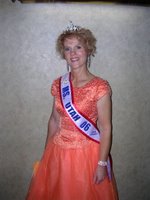I've recently been asked about the affects of aging on the voice. As the population of Baby Boomers increases, there's more concern about changes that occur with the voice as we age.
The voice tells a lot about a person - their state of health, state of mind, and their relative age.
The aging voice is sometimes breathy, scratchy, weak, trembling or rough. As you read the article by Sue Ellen Linville, you'll notice that there's a lot of medical and anatomical jargon that may get a bit deep for you.
In a nutshell, just know that as we age, our parts wear out!!
And when the parts wear out, vocal challenges may set it. Ain't aging grand???
There are certain elements of our respiratory system as well as elements of the vocal mechanism that begin to show the wear and tear of age, and you can hear it in the voice.
BUT HERE'S THE GOOD NEWS! Overall good health, a nutritious diet, low levels of stress, exercise and a good mental attitude will help you keep your voice in youthful, top-shape long into your senior years!
This is why exercising your voice is extremely important! In order to keep all the parts of your vocal mechanism working well, you've got to use them correctly and often. My uncle, Dick Palmer, is 81 years old, and just began singing a year ago! He loves it and it proves that
a voice doesn't have to disintegrate with age. Yes, there may be some changes in the voice, but with good vocal health habits, you can maintain your voice into old age.
If you want to keep your voice healthy and youthful, I suggest that you begin doing daily vocal and breathing exercises. This will help TREMENDOUSLY and you'll see a big difference in the tone, clarity and power of your voice.
If you have a question, or want to learn more about how to maintain your voice, please
contact me.
I will personally answer any question you may have.Also, try my
Viva La Voice Tonic Recipe for a healthy way to maintain your physical and vocal health! All natural and good for you!
Here are some exerpts from an article in the American Speech-Language Hearing Association Journal.
The Aging Voicecite as:
Linville, S. E. (2004, Oct. 19). The Aging Voice. The ASHA Leader, pp. 12, 21
by Sue Ellen LinvilleAs the 21st century advances, senior citizens will make up an increasingly large segment of the population. In recognition of that demographic shift, researchers are developing a database of voice features that are characteristic of normal speakers from young adulthood through old age. Such a database would be invaluable to clinicians struggling to differentiate normal vocal changes with aging from pathologic vocal conditions affecting elderly patients.
Changes in Speech Production Mechanism
The respiratory system changes from young adulthood to old age. In lung tissue, loss of elasticity is considered the most significant change. Other respiratory system changes include stiffening of the thorax and weakening of respiratory muscles. These changes alter lung volumes and respiratory mechanics. While total lung volume remains unchanged in the elderly, vital capacity decreases and residual volume increases. Maximum expiratory flow rate is decreased and lung pressure is decreased. Thus, elderly speakers experience a decline in the amount of air they can move in and out of the lungs and in the efficiency with which they move air.
The larynx also undergoes age-related anatomic changes during adulthood. Glandular changes may cause drying of epithelium, which may increase stiffness of VC cover. Increased cover stiffness could increase instability of vocal fold vibration and raise fundamental frequency (F0) in elderly men.
Some investigators report progressive thickening of the epithelium with aging in both sexes. In males, thickening reportedly is progressive up to age 70, with declines thereafter. In females, thickening is described as progressive, particularly after age 70. Thickening of the laryngeal epithelium may contribute to lowering of fundamental frequency or to increased harshness of voice.
Degenerative changes in the temporomandibular joint are described, along with thinning/loss of elasticity of oral mucosa, declining salivary function, loss of tongue strength, and tooth loss.
Age-Related Voice Changes
Perhaps the voice change that has been investigated most is pitch level. Speaking changes from young adulthood to old age, but the pattern differs according to gender. In women, F0 remains fairly constant until menopause, when a drop occurs (approximately 10 Hz -15 Hz). This drop presumably results from hormonal changes that cause thickening and edema of the laryngeal mucosa. In men, F0 lowers approximately 10 Hz from young adulthood to middle age. The reason for this drop is unclear. After middle age, F0 in men rises substantially (approximately 35 Hz) into advanced old age, reaching the highest level of adulthood.
Tremor and increased hoarseness have been associated with the aged voice. Stability of F0 reportedly declines from young adulthood to old age in both men and women. In men, levels of fundamental frequency standard deviation (F0 SD) more than double between young adulthood and old age. In women, levels jump 71% over a similar period. F0 SD ranges for young and elderly speakers demonstrate little overlap, regardless of gender. In contrast, measures of jitter-the cycle-to-cycle fluctuations in the fundamental period of vocal fold vibration-overlap extensively in young and elderly speakers, especially women.
Amplitude stability also declines with aging, at least in men. Indeed, shimmer, which reflects cycle-to-cycle variation in waveform amplitude, may be a better measure than jitter of chronological aging in men's voices because shimmer levels increase independently of health and fitness variables. Age-related jitter differences disappear if health and fitness are considered.
Another voice quality linked with the aged voice is increased breathiness. While elderly men demonstrate a higher incidence of glottal gap than young men, spectral noise levels do not differ in the two groups. However, spectral noise levels increase in men in poor physiological condition, regardless of age. In contrast to men, both young and elderly women demonstrate a high incidence of glottal gap. However, young women tend to demonstrate posterior chink, while elderly women demonstrate gaps anteriorly in the glottis.
There is acoustic evidence of age-related changes in vocal resonance patterns in both men and women. Lowering of formant frequencies (more pronounced in women) suggests lengthening of the vocal tract. Altered vowel formant frequency patterns (more pronounced in men) suggests centralization of tongue position during vowel production. Altered resonance patterns in elderly speakers may result from growth of the craniofacial skeleton, lowering of the larynx in the neck and/or degenerative changes in oral structures that reduce articulatory precision.
In summary, structural and functional changes occur in the respiratory, phonatory, and supralaryngeal systems with aging. Those changes alter the voice produced by the aged mechanism. Gender differences exist both in the nature and extent of age-related changes.
Sue Ellen Linville is associate professor of speech pathology at Marquette University and the author of Vocal Aging (San Diego: Singular Publishing, 2001). She is an affiliate of Special Interest Division 3, Voice and Voice Disorders. She can be reached at sueellen.linville@marquette.edu.









